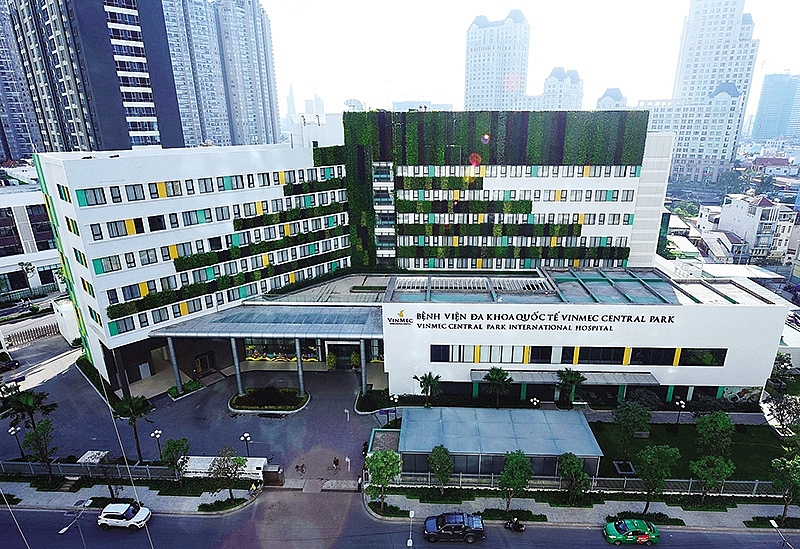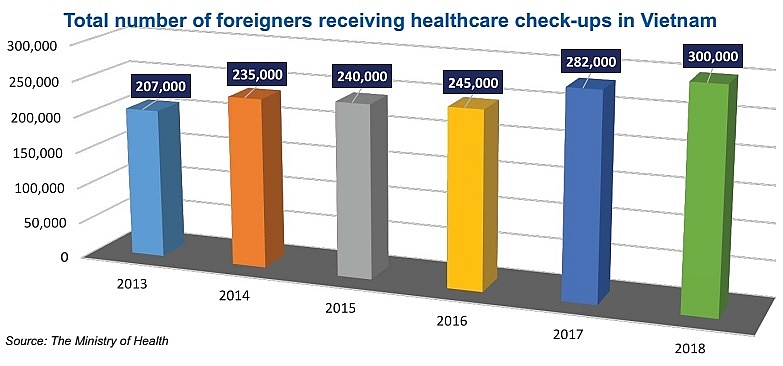Hospitals splash out on better tech and services
 |
| Vietnamese and foreign-invested hospitals alike are investing heavily in infrastructure and technology, Photo: Le Toan |
 |
Without having to wait in long queues or fill out a stack of administrative documents, Phan Van Truong (50) easily and quickly made an appointment for a check-up at Hanoi French Hospital (HFH) through phone in a February morning.
“At other hospitals I would have had to wait in a long queue to register. I am very pleased with the procedures at HFH, where the healthcare infrastructure and equipment are all cutting-edge,” he told VIR.
“Several years ago, when I found out I got diabetes, I visited many famous local hospitals, but in the end I always walked away disappointed. I was enraged by the time- and money-consuming processes. I then decided to go to Singapore where I saw all the most advanced technologies, services, and therapies,” Truong added.
He has been suffering from diabetes for years and spent a fortune on travelling the region, to Singapore and Thailand and even to the EU in search for a remedy. He decided to stop going overseas and get treated at HFH two years ago.
“Many hospitals in Vietnam, especially private ones, are now equipped with advanced technology and offer high-quality services on par with regional standards. They pay more attention to satisfying patients to attract more of them,” Truong said. “Overseas treatment is good, but expensive for a life-long disease like mine. I chose home services as the quality of healthcare has improved a great deal, while the prices are much lower.”
Many of Truong’s friends have come to the same decision and are satisfied with domestic treatment. “If hospitals pay attention to technology investment, I think the quality will increase further and fewer Vietnamese people will decide to go abroad,” he said.
Making heavy investments
HFH is a typical example of how local hospitals are making increasing investments to ride the waves of the 4.0 era and get ahead competition.
Long queues have disappeared from many hospitals which now offer state-of-the-art facilities and innovative technological solutions.
According to industry insiders, public- and private-run hospitals in Ho Chi Minh City and other cities and provinces have been improving service quality in recent years, especially in 2018. HFH has made significant investments in renovation and expansions, as well as talent development. The hospital is going to open a modern building next month and has been purchasing state-of-the-art equipment, aiming to become one of the most high-tech and elegant healthcare facilities.
HFH is now one of the leading integrated healthcare providers in North Vietnam thanks to this development strategy. One of the factors behind its success is that it has been set up in a hotel style for the comfort of patients.
What is more, the hospital follows the Lean 6 Sigma (LSS), which has brought about excellent results: it reduced waiting times, shortened/simplified procedures, and eliminated most waste. LSS is currently the most advanced quality management and improvement system in the world.
Hoa Lam Shangri-La Healthcare LLC, a joint venture between local Hoa Lam Services Co., Ltd. and Singaporean partner Shangri-La Healthcare Investment Pte., Ltd., and FV Hospital are also worthy foreign names that have made heavy investments in state-of-the-art facilities.
Vietnamese-run hospitals are also picking up speed, with Vinmec International Hospital, the healthcare brand of Vietnam’s leading private-run conglomerate Vingroup, as well as Children’s Hospital No.1 and Medical University Hospital (both in Ho Chi Minh City) being the prime names.
For example, Children’s Hospital No.1 is planning to develop more modern check-up and treatment facilities by 2021 under the public-private partnership (PPP) model, aiming to increase its image over rivals.
Medical University Hospital also benefits from medical tourists who have been visiting Ho Chi Minh City in growing numbers to combine travel with medical care in recent years.
According to the Ministry of Health (MoH), these moves have increased the attractiveness of the local healthcare sector, thus changing the minds of Truong and the majority of Vietnamese who previously opted for overseas services.
“We know that Vietnamese people spend billions of US dollars on overseas treatment, but now the trend seems to change. The sector has won the confidence of non-Vietnamese patients, too. Statistics showed that last year around 300,000 non-Vietnamese nationals received examination and treatment in Vietnam, over 50,000 of whom were inpatients,” Nguyen Thi Kim Tien, Minister of Health, told VIR.
“We are trying to increase the number of non-Vietnamese for checks-up and examination and treatment, while attracting more foreigners working and living in Vietnam,” she added.
Challenges ahead
Considering it as its second topmost task in 2019, right after the Lunar New Year holiday, Tien and other leaders of the MoH began working on improving the quality of healthcare services to attract patients. Accordingly, many measures were discussed and tasks were then assigned to specific units.
To achieve the target, the minister said that it is necessary to comprehensively increase the quality of hospitals and clinics in communes, districts, and provinces to ease the overload at central hospitals.
“Central hospitals are still overloaded treating common diseases such as appendicitis, stomachache, headache, and others, thus damaging their image. These diseases should be treated at provincial, district, and communal hospitals, allowing central hospitals to focus on the application of high-tech and offering customised services,” Tien added.
However, this is not an easy task. According to experts, although both private and public hospitals have made efforts to improve service quality in 2018 to attract patients and increase revenue, there still glaring shortcomings.
“There is still a lack of transparency in the reliability and safety index, as many mistakes, medical complications, and nosocomial infections have not been comprehensively assessed and publicised. The current indexes are only external indicators,” they said.
“There should be an independent and reliable unit to study, assess, and publicly cover hospital governance and service quality.”
Another barrier is the lack of a proper legal framework for PPP investment in the healthcare sector. While the MoH said that it is working on a circular guiding the development of PPP projects in the sector in line with Decree 63/2018/ND-CP on PPP legal framwork, and is expected to issue it within this year, no specific deadline has been announced so far.
PPP is an optimal solution for hospitals to achieve financial autonomy. So far, PPP co-operation has helped hospitals improve service quality, as can be seen through the examples of the establishment of the Health Evaluation and Promotion Centre at Cho Ray Hospital in Ho Chi Minh City in 2018 between the hospital and Japan’s International University of Health and Welfare, the dormitory project at Haiphong University of Medicine and Pharmacy, the dormitory project at Ho Chi Minh City University of Medicine and Pharmacy, and the build-transfer project to build new headquarters for Hanoi University of Public Health.
With these challenges, the MoH, its units, and hospitals will have to do their utmost to keep today’s achievements and retain the confidence of Truong and other Vietnamese patients, thus preventing the drain of money in the rapidly changing world of healthcare.
What the stars mean:
★ Poor ★ ★ Promising ★★★ Good ★★★★ Very good ★★★★★ Exceptional
 Tag:
Tag:
Themes: Healthcare
Related Contents
Latest News
More News
- Protect what’s next: towards a future free from meningococcal group B disease (December 05, 2025 | 18:00)
- New ILO report offers policy recommendations for disability inclusion (December 04, 2025 | 15:18)
- Maternal job loss may affect children’s mental health, research shows (December 03, 2025 | 19:11)
- Women lead Vietnam’s shift to climate-resilient agriculture (December 03, 2025 | 19:10)
- Experts highlight unpaid care work as key barrier to gender equality (December 03, 2025 | 15:15)
- Opportunities and inequalities for women workers in Vietnam's garment industry (December 03, 2025 | 09:00)
- Vietjet flights carry love to devastated central region (November 28, 2025 | 11:35)
- New initiative to boost the fight against domestic violence (November 26, 2025 | 10:00)
- South Korea funds IOM relief for Vietnam’s typhoon-affected communities (November 24, 2025 | 15:33)
- AI and human-centred values set to shape the future of HR in Vietnam (November 21, 2025 | 18:04)






















 Mobile Version
Mobile Version